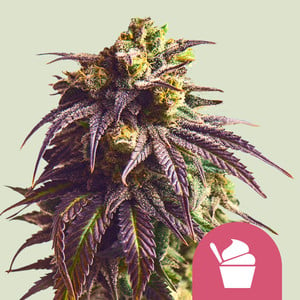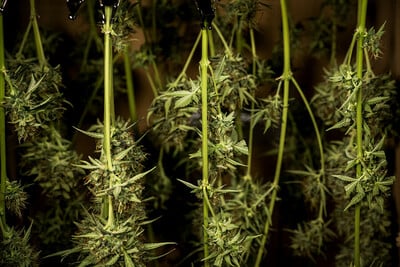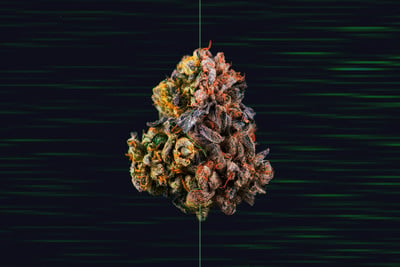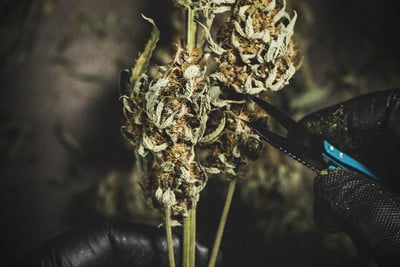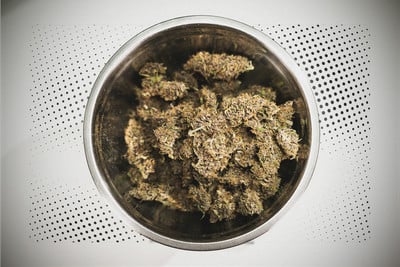.

How to Add Flavour to Your Cannabis Before, During, and After Harvest
Cannabis buds don't always taste as good as they should. If your harvest is lacking the aromatic kick you're used to, know that there are plenty of ways to influence the flavour! These include careful strain selection, using fungal inoculants, and even adding dried fruit peels to your stash jars. Keep reading to find out more.
The taste of your weed flowers isn’t set in stone! Rather, it’s a variable that growers can easily influence using nutrients, strain selection, and even—wait for it—dried fruit peels! Find out how to make your weed taste better than ever.
Contents:
Can You Really Enhance the Flavour of Weed?
Many cannabis strains taste great by default, considering they’re grown and processed with due care and attention. However, there are scenarios where the terpene profile of a strain may not be adequately expressed, or someone isn't happy with the flavour of the end product. With this in mind, some may wonder how to make weed taste better. If you’ve ever asked yourself this question, you’ll be pleased to know there are a range of options available to growers of all stripes.
You can improve the taste of weed using methods as simple as good strain selection, and as obscure as applying essential oils to your buds. Organic gardening strategies, such as bioinoculants and companion planting, can also help to tip terpene profiles in a more favourable and flavourful direction. Continue reading to discover how to make your cannabis buds tastier than ever—before, during, and after harvesting.
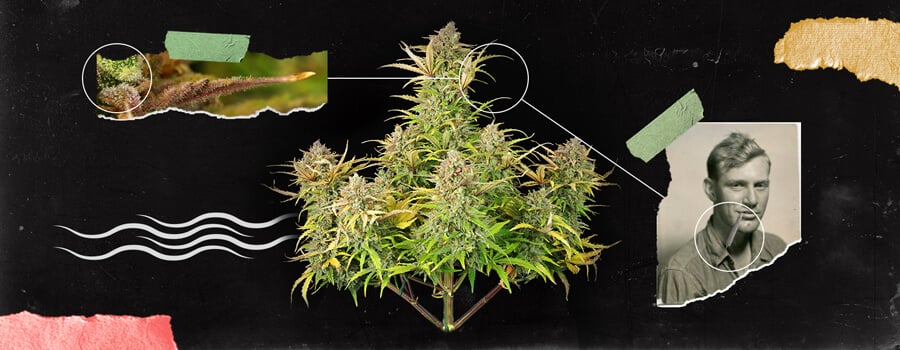
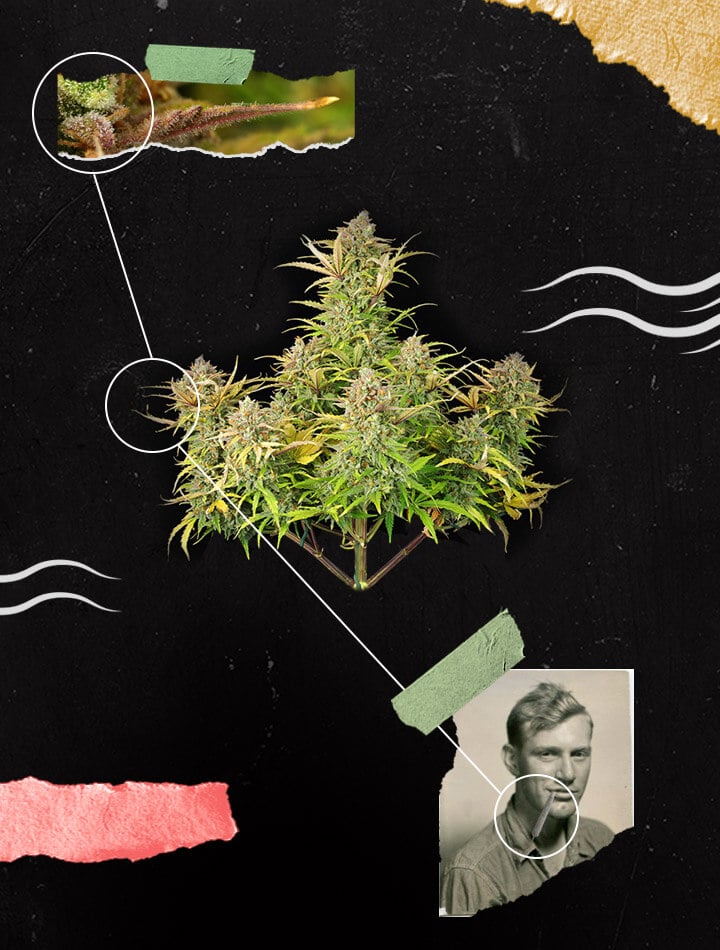
How to Add More Flavour to Your Cannabis Before Harvest
Achieving a flavourful stash starts even before you put seeds in the soil. If you want to optimise the aroma and taste of your plants for the highest-quality results, consider the following tips and methods.
Start With Naturally Flavoursome Strains
When it comes to growing weed, cultivators can resolve so many issues by simply choosing the right genetics for the task at hand. Instead of choosing a wimpy, weak, and underwhelming strain and hoping to improve it with an ideal environment, skip the nonsense and set yourself up for success from the start. Pairing superb genetics with refined environmental metrics will result in high-quality, exceptionally flavourful buds.
The age-old process of selective breeding has allowed seed banks to develop tailored terpene profiles that suit every possible taste out there. While some strains are purely bred for THC content, CBD content, or particular morphological characteristics, others are created chiefly with flavour in mind.
If you want buds packed with fruity, skunky, or earthy scents, then you need to choose the right cultivars from the get-go.
Royal Bluematic
Our skilled breeders at Royal Queen Seeds created Royal Bluematic by crossing the legendary Blueberry with a high-performing ruderalis specimen. This resulted in an autoflowering cultivar that explodes from shoot to harvest in as little as 11 weeks, and is packed with mouth-watering terpenes. Prepare to experience moreish tastes of fruit, blueberry, and earth with every hit. As a bonus, she serves up a powerful stoning high perfect for the evening. Expect a rewarding yield of 425–475g/m² from indoor plants and up to 120g/plant from their outdoor counterparts.
Royal Bluematic
|
|
Blueberry x Ruderalis |
|
|
425 - 475 gr/m2 |
|
|
60 - 75 cm |
|
|
7 - 8 weeks |
|
|
THC: 14% |
|
|
Sativa 10% Indica 60% Ruderalis 30% |
|
|
70 - 120 gr/plant |
|
|
70 - 100 cm |
|
|
11 - 12 weeks after sprouting |
|
|
Powerful , Stoned |
Sundae Driver
Sundae Driver has become a go-to cultivar for many growers, for a variety of reasons. Above all else, her insanely pungent terpene profile has elevated her above the many hundreds of other strains available. The complex mix of phytochemicals within her buds gives rise to delicious flavours of berries, earth, and vanilla. To add even more to the equation, her stunning and compact buds boast mesmerising shades of dark purple. This progeny of Fruity Pebbles OG and Grape Pie maintains a medium height and delivers a euphoric and motivating high. Prepare to harvest up to 450g/m² and 500g/plant from indoor and outdoor plants respectively.
Sundae Driver
|
|
Fruity Pebbles OG x Grape Pie |
|
|
400 - 450 gr/m2 |
|
|
90 – 140 cm |
|
|
9 - 11 weeks |
|
|
THC: 23% |
|
|
Sativa 50% Indica 50% |
|
|
450 - 500 gr/plant |
|
|
130 - 170 cm |
|
|
Early October |
|
|
Balanced, Euphoric, Motivating |
Somango XL
Growers usually have a specific preference when it comes to a strain's taste. Some love sugary notes, others prefer things skunky, and many simply can’t resist fruity phytochemicals. If you autumn into the latter camp, then you need to become acquainted with Somango XL immediately. Born out of a cross between Somango and Critical 47, this indica-dominant hybrid emerged with boatloads of fruity terpenes and a THC content of 18%. Brace yourself for a hard-hitting stone when you cram these buds into bong bowls and blunts. Expect to stash away up to 575g/m² from indoor plants and 600g/plant from those raised outside.
Somango XL
|
|
Somango x Critical 47 |
|
|
525 - 575 gr/m2 |
|
|
60 - 100 cm |
|
|
8 - 10 weeks |
|
|
THC: 18% |
|
|
Sativa 25% Indica 75% |
|
|
550 - 600 gr/plant |
|
|
120 - 200 cm |
|
|
Late September |
|
|
Powerful , Stoned |
Grow Using a Super Soil Mix
Have you heard of super soil? If not, you’re missing out! This type of growing medium guarantees productive, vigorous, and terpene-filled plants. You see, super soil is carefully crafted to include everything plants need to achieve an optimal level of health and performance. Weed plants need a specific set of nutrients to carry out biological processes such as the creation of energy and the synthesis of terpenes. Treat your plants to a super soil mix and they’ll return the favour in the form of higher concentrations of terpenes and, therefore, superior flavours.
Inoculate With Mycorrhizal Fungi
Did you know that around 90% of all land plants form an alliance with soil-dwelling fungi? Yeah—they literally allow these organisms to fuse themselves to their roots. Once connected, they kickstart a mutually beneficial relationship. Plants create sugars using sunlight, and pump them down into the root zone to allow the fungi to dine on carbon-based molecules. In return, the fungi shuttle nutrients into the root network. However, mycorrhizal fungi offer much more than nutrients. They also help to protect plants against root pathogens and, as research[1] demonstrates, boost concentrations of desirable terpenes.
Consider Companion Planting
Companion planting refers to growing beneficial plants in close proximity to your cannabis crop. This strategy offers numerous benefits; it drives soil microbiology, deters pest insects, and draws in beneficial predatory and pollinating species.
And, although studies in this area are lacking, some growers attest to the effectiveness of using aromatic companion plants to boost terpene levels in nearby cannabis plants. It’s known that plants can communicate using terpenes; indeed, many vegetable growers claim that growing basil near their tomatoes dramatically increases the flavour of their crop. Why not give this trick a go and see the results for yourself?
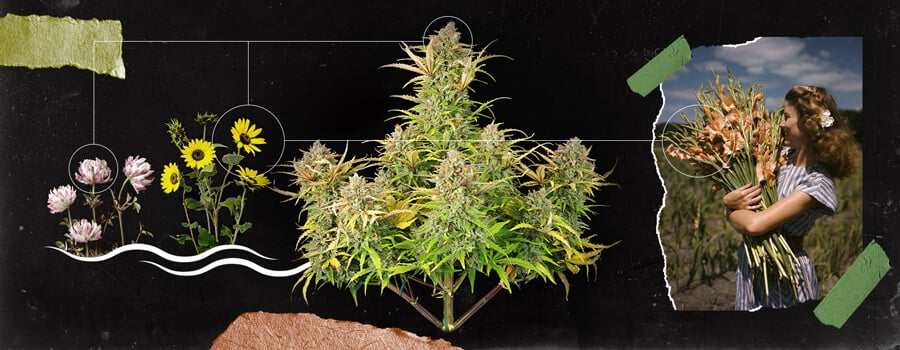
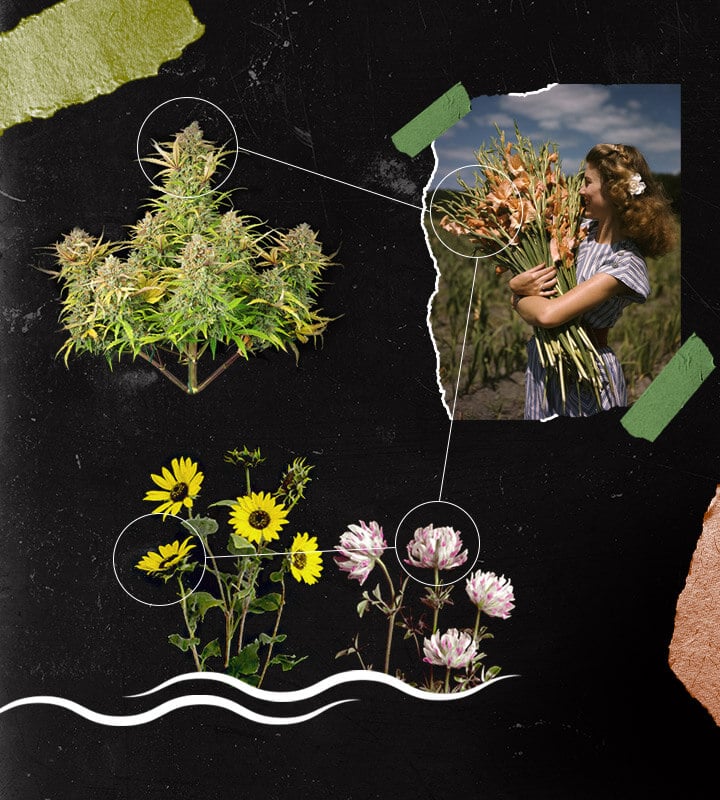
Apply Bloom Booster Supplements
Bloom boosters are exactly as they sound; these products contain everything that weed plants require to develop healthy flowers packed with cannabinoids and terpenes. The formulas vary depending on the product, but generally they contain the elements listed below. As well as assisting flower development, these minerals drive terpene synthesis, thereby increasing the flavour of the buds.
- Magnesium: This secondary macronutrient serves as a cofactor for enzymes that help to build the precursors of terpenes.
- Zinc: Essential in the activation of key biosynthetic enzymes, zinc catalyses the conversion of simple precursor molecules into more complex terpene compounds.
- Iron: This micronutrient serves as a cofactor for enzymes involved in the creation of terpenes such as geraniol and farnesene.
How to Add More Flavour to Your Cannabis During Harvest
Right then, you've just discovered some key ways to make your weed taste better during the cultivation process. Next up, we’re going to cover some ways to improve the flavour of your buds during harvest. If your flowers aren’t smelling too special at this stage, there are still several steps you can take to give them an edge—some controversial, others more routine.
Stop Watering
Adequate levels of light, bioinoculants, and nutrients help cannabis plants to achieve peak health and produce massive levels of terpenes. But make no mistake, pampering your crops isn’t the only means of sending concentrations of aromatics sky-high. You see, in nature, plants manufacture terpenes to deal with external stress, including pests, pathogens, and adverse weather.
Research[2] shows that drought conditions force plants to produce more terpenes in an attempt to preserve themselves during such an event. More specifically, they produce more monoterpenes. In cannabis, these compounds include the likes of myrcene and pinene. With this in mind, stop watering completely several days before harvest for a bump in terps.
Hydrate Cannabis Buds With Flavoured Water
We get it—this method sounds bizarre. But hear us out! Some growers swear by this technique as a means of improving the flavour of their crop. Post-harvest, take a living branch with several colas still attached. Fill a glass with water and add a couple of drops of your favourite essential oil. Place the cutting into the glass and let it soak up the water for the next couple of days. Proceed to dry and cure as normal. This one sounds weird, but you’ll need to try it for yourself!
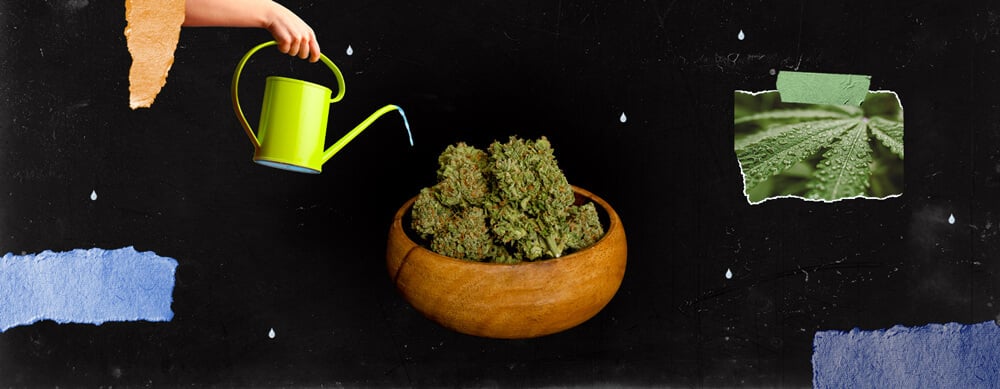
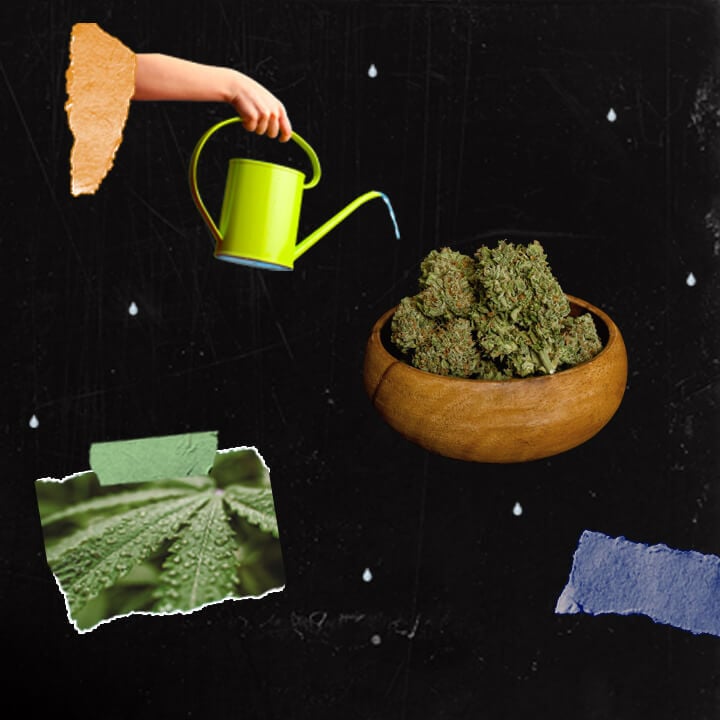
How to Add More Flavour to Your Cannabis After Harvest
We’ve covered effective ways to improve the flavour of your weed buds before and during harvest. Now, you’re going to discover how to send taste through the roof after processing your buds!
Use Food-Grade Extracts or Essential Oils
First up, we have another unusual option. Please, view this as a possibility rather than an endorsement! Some growers take a rather extreme step of coating their buds in food-grade extracts and small quantities of essential oils. These products markedly change the taste of weed flowers and allow growers to fully customise the flavour and aroma of each bud. However, it’s possible for these applications to cause lung irritation, or worse, when combusted and inhaled.
Add Dried Fruit Peels
This option is definitely safer, more sensible, and still effective. Adding dried fruit peels to your stash jars can help to infuse surrounding buds with mouth-watering terpenes. While not as pungent as essential oils, this less-concentrated source of terps imparts a subtle boost in flavour. Flavouring weed with orange peel is a firm favourite, but lemon, lime, and grapefruit are also great options. Just make sure your peels are fully dried out before adding them to jars to avoid introducing excess moisture into the environment.
Take Your Time With Curing
Curing plays an extremely important role in making weed taste better after harvest. This process involves placing dried buds into airtight jars to facilitate the breakdown of unwanted, harsh-tasting molecules such as starches and chlorophyll. Ideally, growers should cure their buds for at least two weeks. We know the temptation to blaze is often irresistible, but curing for around eight weeks will pay off in the form of deliciously enhanced flavours.
The Secret to Extra-Flavoursome Weed
There you have it! You’re now equipped with several effective strategies for improving the flavour of your cannabis buds. You know that strain selection reigns supreme, and how to influence terpene levels during cultivation. On top of this, you’re ready to influence the taste and aroma of your flowers during and after the harvesting process. So, what are you waiting for? Put these techniques to the test and decide which methods you prefer the most!
- Terpenoids in plant and arbuscular mycorrhiza-reinforced defence against herbivorous insects - PMC https://www.ncbi.nlm.nih.gov
- Short-term severe drought influences root volatile biosynthesis in eastern white pine (Pinus strobus L) - PMC https://www.ncbi.nlm.nih.gov



























